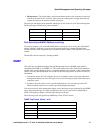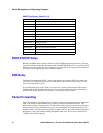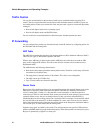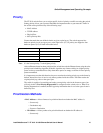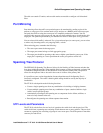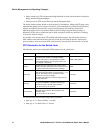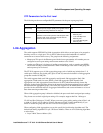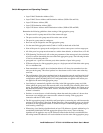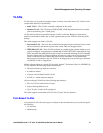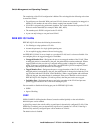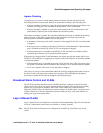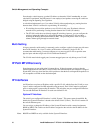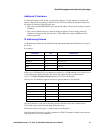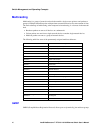
Intel® NetStructure™ ZT 8101 10/100 Ethernet Switch User’s Manual 33
Switch Management and Operating Concepts
STP Parameters for the Port Level
The following are the user-configurable STP parameters for the port or port group level.
Link Aggregation
The switch supports IEEE 802.3ad Link Aggregation which allows several ports to be grouped so
that they can act as a single port. This is done to either increase the bandwidth of a network
connection or to ensure fault recovery. The group has the following assignments:
• Master port-This port is the Ethernet port with the lowest port number. All member ports are
configured to use its port settings and become members of its VLAN.
• Anchor port-This port is in charge of sending control packets, such as spanning tree BPDUs,
and also the flooding of multicast frames. When a link change event occurs in the group, the
anchor port may be re-elected.
The ZT 8101 supports up to six link aggregation groups, each of which may include from 2 - 8
switch ports. However, the gigabit ports (ports 25 and 26) cannot be included in a link aggregation
group that contains 10/100 ports.
The switch supports both static link aggregation and dynamic link aggregation. Static link
aggregation (Trunk mode) lets users define a fixed link aggregation path. Dynamic link
aggregation uses Link Aggregation Control Protocol (LACP) which automatically detects the
presence of other link aggregation devices in the network and lets them exchange data to configure
and maintain link aggregation groups. The switch also supports LCAP Marker Protocol which
provides for the controlled removal of aggregate link members and assures minimum or no loss of
data when removing member links.
When a link aggregation group is deleted or disabled, the ports retain their reassigned port settings.
They do not recover their original port settings. For example, suppose that Port 1 belongs to
VLAN1 and Port 2 belongs to VLAN2. When you create a group with a starting point of Port 1 and
a width of 2, Port 2 will be added to VLAN1 and removed from VLAN2 automatically. If you
delete or disable the group later, the Port 2 will still be assigned to VLAN1.
When configuring Link Aggregation you can also specify the load sharing algorithm used. The
default load sharing algorithm is Layer 3 IP Source Address. There are six load sharing algorithms
to select from:
• Layer 2 MAC Source Address (SA)
Variable Description Default Value
Port Priority
Specifies the relative priority for each port. Lower
numbers specify a higher priority and a greater chance
of a given port being elected as the root port.
128
Port Cost
Specifies a value used by STP to evaluate paths. STP
calculates path costs and selects the path with the
minimum cost as the active path.
• 100 for 10 Mbps Fast
Ethernet ports
• 19 for 100 Mbps Fast
Ethernet ports
• 4 for 1000 Mbps Gigabit
Ethernet ports



